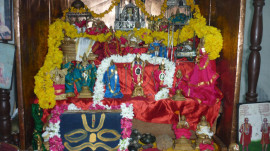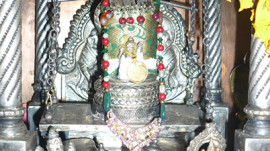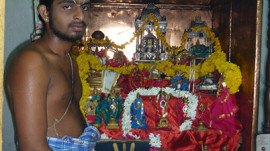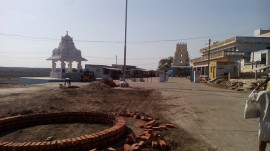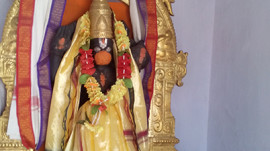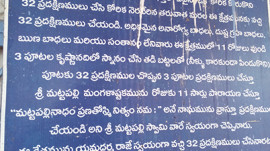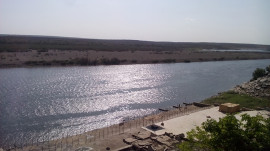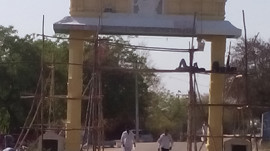Mattapalli Narasimha Temple
Facts- This is one of the Panchanarasimhar kshetram in Andhra
Video
(Vedadri, Vadapalli, Mattapalli, Mangalagiri, and Ketavaram).
- Sri Mukkoor Lakshmi Narasimhacharaiyar has done many swathi yagnas in this kethram. He has opened a goshala here.
- This Mahakshetram is situated on the banks of river Krinaveni & is 140km from Vijayawada.
- Thayar thirunamam: Rajya Lakshmi Thayar
- Moolavar: Shree Yoganandha Lakshmi Narasihmar.
- Vimanam: Brahmaanandha Nilaya Vimanam.
- Theertham: Krishnaveni Theertham.
- Rishi aradhana Kshetram: Sri Bharadwaja Maharishi worshiped in this place.
Location
Mattapalli is situated on the banks of river Krishna, in Huzurnagar taluq of Nalgonda District in Andhra Pradesh, India.Presiding Deities
The presiding deities of this temple are: Sri Yogananda Lakshmi Narasimha Swamy, Sri Raajyalakshmi Thaayar, and Sri Chenchu Lakshmi Thaayar.Sthala Puranam (Temple in the legends)
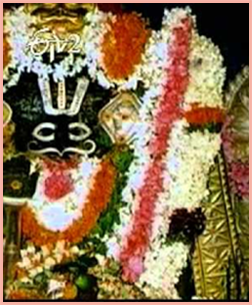 The Maha Kshetram is in the midst of a dense and lovely forest, which instills awe and inspiration in the minds of the visiting pilgrims.
The Maha Kshetram is in the midst of a dense and lovely forest, which instills awe and inspiration in the minds of the visiting pilgrims.
In one of the caves adjoining the pilgrim town, the image of the Lord has been radiating glory from times immemorial. Legend had it that Sri Bharadwaaja Maharshi worshipped this deity everyday accompanied by several other sages. In those unknown times, only sages and gods could worship the self revealed images of Narasimha in the cave. The sages who had the welfare of this world at their heart decided to throw open this holy place to the common man. An auspicious time for this came in during the Kali Yuga.
The deity was revealed in a dream to the devotee Sri Anumala Machireddi, the ruler of Thangeda which is 3 km off Mattapalli on the opposite bank of river Krishna. The Lord wished Machireddi to reveal his image for the good of the mankind during Kali Yuga.
The ruler accompanied by his pandits, searched all the caves on the banks of river Krishna, as ordained by the Lord, but could not trace the location of the deity. Sad and depressed, he fell asleep in the forest. Again the Lord appeared in his dream and ordained him to search further, in a designated area near an “Aare” tree hidden behind the foliage in a cave.
Waking up, the ruler found the cave and the image of the Lord in a seated posture, with the wellspread hood of Sesha over his head, fully adorned with Shankha Chakra Gadha and as if the Lord was being worshipped regularly, with flowers, sacred leaves, fruits etc. Overjoyed, the ruler revealed the Maha Kshetram to the general public and constructed a Mukhaalaya.
About Sri Anumala Machireddy
The name and fame of Machireddi has lived down to this day and we still see his benevolence and benefaction inscribed in the golden kalasams in the Siva temple of Srisailam, and others like Kasi Visheswara, Lord Gopala in Thangeda etc. However, the fort of Thangeda is now in ruins.Chennuri Sri Narasimha Rao, Chairman of the temple committee, said that one “Chennuri Giramma”, belonging to his great-grand-forefathers was an ardent devotee of Sri Mattapalli Narasimha. She lived during the period of the Mughal emperor Aurangazeb.
When Mughal forces were to attack the temple, she prayed to the Lord to dispell the danger. Then the Lord created countless bees which attacked and drove the Mughal soldiers away. Their attempt to capture this temple proved a futile exercise. However, there is no historic recorded information to support this.
Temple Architecture
Garbhagriha (sanctum sanctorum)There is a rock above the door to the sanctum sanctorum. On it is the sculptured motif of Gaja Lakshmi with two elephants raising their trunks upwards on either side. The sanctum is a cave. The roof of the Garbhagriha is a big rock.
The Lord manifested Himself on a rock, which is on the backside of the Garbhagriha. Another rock is spread like the hood of Sesha over it. The Lord is one foot in height. Seated in Padmasana, He holds a Chakra in His upper right hand and Sankha in His upper left hand. He has kept His lower left hand on His left knee, and His lower right hand is not visible. On the left side of the Lord, ther are decorated three Namams (Thirumann), and two eyes, which are considered as the form of Prahlada, the ardent devotee of the Lord.
There is a small lengthy rectangular rock of about one foot length at the feet of the Lord. The rock is said to be “Chakri”, an ardent devotee of the Lord who was not given mukti when he requested for the same because the Lord did not want to be separated from him. So he was made into a rock like form and placed in the sanctum. Daily the abhishekam is performed to this rock also.
To the left of the manifested Lord, there is a black, stone image of Lakshmi which is 1.5 feet in height, in a sitting posture on a lotus. She holds lotus flowers in her upper hands. Her lower right hand is in Abhaya posture and the left hand is in Suchi posture.
Below the Lakshmi image, there is another image of Lakshmi, which is carved on a rock. As Lakshmi is not visible to the visitors, the image of Rajya Lakshmi is installed for the ‘darsan’ of the devotees. It was consecrated in 1975. She holds Chakra in her upper right hand and Sankha in her left hand. She holds lotus buds in her lower hands. She is in sitting posture. She is 1.25 feet in height. She wears a Makuta on Her head.
Before the presiding deity, at a lower level, the utsava idols of the Lord are installed. There are also copper images of Sudarsana, Nammazhwar and another Azhwar.
To the right side of the sanctum, leading to the north door, there are eleven black stone images of the Azhwars, seven of which face the west and the remaining four face east. There is a trench on the left side of the Lord at some distance in the cave, which it is believed to lead to the river Krishna through an underground passage.
Description of the temple
The sanctum faces the west. The mukhamantapam has 21 pillars with a cement roof. Before the Vaikunta Dvaara (North door) there is a mantapa with five pillars with a cement roof. It was built in 1973-75. It measures 21 feet X 18 feet. The mukhamantapam before the sanctum measures 24 feet X 45 feet. The height of the mukhamantapam is about 20 feet.
As there is no convenience to go around the sanctum, the devotees perform circumambulation (pradakshinam) around the Dhwajasthambha and the stone image of Hanuman which faces the Lord. There is a Ramanuja Kutam (Madapalli or kitchen) to the north of the temple in the same premises where in, the naivedya to the Lord is prepared.
There is an entrance to the temple which faces the south. There is a fleet of steps leading down to the river Krishna just outside the main temple but within the compound.
Temple Traditions
Vaikhaanasa Aagama is followed here. The priest is a Sri Vaisnava who is a heriditory priest. There is a Vedic pandit who recites Vedas and other mantras at appropriate occasions.The daily programme of the temple is as follows:
- 05:00 Suprabhatam
- 06:00 Viswaroopam and Abhishekham (after removing kavachams)
- 07:00 1000 Darsanam
- 10:00 Sahasranama Archana
- 11:30 Balabhogam and Viniyogam
- 12:00 Dvarabandhanam
- 16:00 Reopening of Temple doors and Archana
- 17:00 – 19:00 Darsanam
- 19:00 Naivedyam and Viniyogam
- 19:30 Kavaatabandhanam
Events
Every Friday, there is a seva of Andal at 6pm with the procession by devotees. Adhyayana utsavas precede the annual festival of the Lord for 3 days from Chaithra Sudhdha Dasami to Dvadasi. The annual festival is celebrated from Chaithra Sudhdha Trayodasi to Bahula Tadiya.The following festivals are celebrated in the temple viz., Ugadi, Sri Raama Navami, Sri Nrusimha Jayanthi, Sri Krishna Jayanthi, Vijaya Dasami, Vaikuntha Ekadasi, Dhanurmasa Aaradhanam and Sankaranthi.
On the occasion of the Brahmotsavas, Mukkoti Ekadasi and Nrusimha Jayanthi, about 5000 devotees from local and other areas congregate. During these days, one-act-plays, dramas, dances, harikatha, bhajan and songs afford entertainment to the devotees.
The special feature of this temple is giving free food (annadana) to all the pilgrims on these days.
Importance of this Kshetram
There is a popular verse which goes thus:“Ekameva Kshetram, Mattapalli Kshetram,
Na Anyat Kshetram, Mattapalli Tulyam,
Ekameva Tatvam, Mattapalli Naatham,
na Anyat Tatvam, Palli Simha Tulyam“
which means,
“Mattapalli is the only pilgrim spot.
There is no secondary whatsoever and there is no equal to it.
There is only one Lord and He is the Lord of Mattapalli.
There no secondary whosoever and none is comparable to him.”
There is a belief that incurable diseases will be cured and the evil spirits will be driven out and all desires will be fulfilled by the Lord if one stays in Mattapalli for 11 days and 11 nights and performs 32 pradakshinams thrice a day with wet clothes having bathed in the Krishna river each time.
Another important feature is the possession of a rare type of conch by the temple called Dakshina Vriththa Sankha. It is said that if one keeps it near his ear, a booming sound of the sacred Pranava also called Taaram, echoes out of it. This type of conch is present only at the Kasi temple and nowhere else.
How to reach this place?
The city is 25km from Huzurnagar. Huzurnagar can be approached from Kodada or Miryalaguda. Kodada is on the Vijayawada – Hyderabad Highway and is 15km from Huzurnagar. Kodada is 175km from Hyderabad and 100km from Vijayawada.The nearest railway station to Mattapalli is Miryalaguda railway station Junction which is 33 KM away from Mattapalli.
Divya Kshetra
- Ahobila
- Kadiri
- Simhachalam
- Mangalagiri
- Yadagiri Gutta
- Vedadri
- Antarvedi
- Vadapalli
- Kethavaram
- Narasimha Konda
- Mattapalli
- Melkote
- DevarayanDurga
- Hariharapuram
- Saligrama
- Jharni
- Seebi
- Pataladri
- Kadighachalam
- Naamakkal
- Anthili
- Parikkal
- Poovarasankuppam
- Sinirkudi
- Thiruvadigai
- Kole
- Indapur
- Pokharni
- Marjāra
- Puri
- Narasingapalli
- Jyothir Mutt
Please share your comments / inputs by submitting the form.
To share the images, please email us at srinarasimhakutumbam@gmail.com with the respective Divyakshetra subject header. Please restrict the no of images to 4 & size within 2 Mb.

